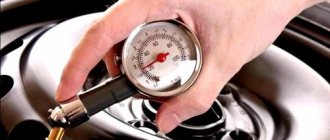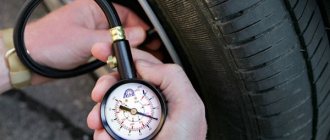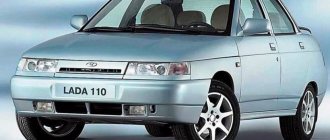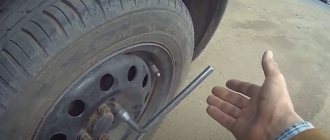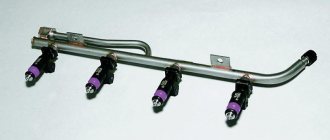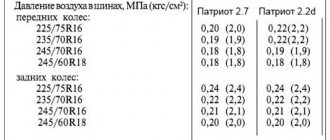The pressure in Volkswagen Polo tires must comply with the standards established by the manufacturer. Each modification has its own parameters. Front and rear wheels have different indicators. The degree of inflation is affected by the time of year the car is used and the quality of the road. If only the driver is behind the wheel, then the front and rear of the Volkswagen can be inflated at a level of 2.0 atm. When the car is fully loaded, the tires on the front axle should be inflated to 2.4, and the rear axles to 2.6. On the Polo GT sports car, under standard load, the front tires receive a pressure of 2.2 atm, and the rear tires - 2.0 atm. Under load, the main ones are 2.4, and the rear ones are 2.8.
It is necessary to monitor the tire pressure immediately after the car leaves the factory. Otherwise, with low inflation, increased rubber wear will be observed. If the boost is increased, then due to reduced contact with the road surface, vehicle handling will deteriorate.
Tire pressure Polo R15
When using such tires, the wheel inflation parameters correspond to R14 tires. In summer, the front and rear wheels are inflated to 2.0 and 1.8 atm. In winter, tire parameters decrease by 10% relative to the presented value.
When installing R15 tires, when the car carries a large number of passengers and there is cargo, in the summer the front is inflated to 2.4 atm, and the rear to 2.6. In winter it also decreases by 10%.
The evolution of people's cars
The idea of founding the Volkswagen concern itself was dictated by the requirement of the German government to create for the people of Germany a reliable and durable car that would cost no more than 100 Reichsmarks. It is this concept - the production of good and inexpensive cars - that remains the leitmotif of the brand to this day in the development of each new model.
Europe chooses Volkswagen Polo
From the very first release, this compact car immediately became a favorite among German drivers. There are several modifications of its model range:
Volkswagen Polo was named the best car in Europe and the world
Over all 5 generations of this model, the developers have worked tirelessly to constantly improve both the aerodynamic and aesthetic properties of the cars, as well as to improve the technical part. An excellent testament to their fruitful work is the fact that in 2010 the Polo was awarded the title of “best car of the year in Europe and the world” (according to Previous Winners).
The interior of the Volkswagen Polo has very high-quality seat trim
In fairness and for a more objective assessment, in this review we will compare which is better: the Volkswagen Jetta or the Volkswagen Polo Sedan. There are two explanations for this.
Firstly, the Polo Sedan was the first car in the history of the concern that was specially designed for Russia, adjusted for climatic conditions, road conditions and fuel quality.
As a result of numerous tests carried out during the development of the model, the Polo Sedan received a galvanized bottom and was equipped with a reinforced suspension and a powerful, unpretentious engine. And secondly, this way we can achieve a comparison of two models made in the same body and located in approximately the same price category.
Swift as the air current - Volkswagen Jetta
When creating the Volkswagen Jetta, manufacturers took the VW Golf as a basis.
The start of Jetta production dates back to 1979. It was based on the Volkswagen Golf, but unlike the shortened hatchback body of the latter, the standard VW Jetta body is a classic sedan. The name of the model range was borrowed from aviation and means high-altitude jet stream (Jet-stream). Over the entire history of the Jetta, 6 generations of the car were produced:
The interior of the Volkswagen Jetta combines spaciousness and comfort.
Unlike previous generations, Jetta VI cars, according to the developers themselves, have absolutely nothing in common with the Volkswagen Golf. And in December 2014, it was planned to release a new conceptual all-terrain version of the Jetta - Jetta Alltrack.
Comparative characteristics
It is more convenient to compare the Volkswagen Polo and Volkswagen Jetta according to individual parameters for a better understanding of the differences and features of each model.
| Car model: | Volkswagen Polo | Volkswagen Jetta |
| Manufacturer country: | Germany (assembly Russia, Kaluga) | Germany |
| Body type: | sedan | sedan |
| Number of places: | 5 | 5 |
| Number of doors: | 4 | 4 |
| Engine capacity, cubic meters cm: | 1598 | 1598 |
| Power, l. s./about. min: | 105/5250 | 105/5250 |
| Maximum speed, km/h: | 190 | 180 |
| Acceleration to 100 km/h, s: | 10.5 (manual transmission), 12.1 (automatic transmission) | 11.5 (manual transmission), 13.1 (automatic transmission) |
| Type of drive: | front, transverse | front, transverse |
| Checkpoint: | 5 manual transmission, 6 automatic transmission | 5 manual transmission, 6 automatic transmission |
| Fuel type: | gasoline AI-95 | gasoline AI-95 |
| Consumption per 100 km: | city 8.7; route 5.1 | city 9.8; highway 5.4 |
| Length, mm: | 4384 | 4644 |
| Width, mm: | 1699 | 1778 |
| Height, mm: | 1465 | 1482 |
| Ground clearance, mm: | 150 | 160 |
| Tire size: | 175/70R14, 185/60R15 | 195/65R15 |
| Curb weight, kg: | 1159 | 1302 |
| Total weight, kg: | 1660 | 1800 |
| Fuel tank volume: | 55 | 55 |
Interior and exterior
The design solution in the interiors of both models looks quite presentable. Still, the Polo has a more interesting seat trim, but the Jetta has a better on-board computer.
As for the body dimensions, the Jetta has a more comfortable and spacious interior, offers more space for rear passengers and is 10 cm longer than its brother.
Although the Polo's trunk is quite roomy, the Jetta clearly has more advantages when it comes to cargo transportation.
Dynamism, comfort, controllability
What distinguishes the Polo from the Jetta with the same characteristics of the power units is that it has an increased intensity of acceleration dynamics. This means that with the same 105 hp engines. With. and a volume of 1.6 liters, the Polo accelerates to hundreds one second faster than the Jetta and at the same time consumes less fuel.
Test drive a Volkswagen Polo:
In terms of driving comfort, both models are worthy of respect, but the Jetta still has a slight advantage on roads with uneven sections. Although the Polo, equipped with a 1.6 liter engine, has better handling characteristics and is more docile on the road.
Optionality
Regardless of whether Polo or Jetta is presented to our review, we can highlight a set of equipment that is common to both versions:
Tire pressure monitoring system Polo sedan
The function provides the driver with information about tire problems. In each wheel of the car, behind the spool rod, there is a sensor that supplies information to the control unit. If one of the tires is flat, the light on the instrument panel begins to blink. This continues for 1 minute. When the fault is not corrected, it continues to light continuously.
Sometimes, after installing the spare tire, the light remains on. The reason is that the new sensor has not been initialized. Only after completing the procedure will the light go out.
Also on the Polo Sedan there may be indirect control of the roller inflation. It is based on fixing the number of wheel revolutions. An ABS unit is installed in the car. If the tire pressure decreases, the outer diameter of the wheel decreases and the number of revolutions decreases. Based on the information, the sensors give a signal about insufficient pumping.
Selection of tires to match the wheel size of a Volkswagen Polo car
When installed on a Volkswagen Polo, the manufacturer of 14-inch “stampings” recommends 175/70/R 14 tires. For the second option, 185/60/R 15 is suitable, and for light alloy wheels – 185/60/R 15 and 195/55 /R 15. Other important wheel indicators that may be needed when choosing tires can be found in the technical documentation.
For those who are choosing tires for the Volkswagen Polo for the first time, it’s best to first familiarize yourself with the designations on the tire. There's nothing complicated about it. In addition to the digital designations of tire sizes, the marking may also contain letters indicating the maximum safe speed for a given tire.
IMPORTANT! Exceeding speed limits is DANGEROUS! Most accidents and accidents involve violation of tire speed limits.
Pressure in the slopes of the Polo sedan in summer and winter
Typically, a car is equipped with alloy wheels with R15 -185 60, R15 195/55 tires. Be sure to adhere to certain standards for pumping up stingrays. Parameters change depending on the release date of the VW Polo modification.
- 2011. If R15 tires are installed, then in summer in good weather on a flat road the pressure in the front should be 2.1 atm, and in the rear 1.9. In winter the norm is different: 2.0 and 1.8 atm. The same pressure should be in the tires when driving on a wet road or unpaved surface.
- 2012. In the summer with R15 tires - 185/60, the pressure is 2.1 in the front and 1.9 in the rear. In winter, the degree of pumping should decrease within 0.1-0.2 atm. The wheels are lowered by the same amount in wet weather.
- 2013. Boost standards correspond to Polo 2012.
- 2016. For R15 tires, the pressure in summer should be 1.9 atm. In winter and bad weather, 1.9 will do.
- 2018. Similar to 2016 cars.
- 2019. With R15 185/60 tires, the drivers pump up to 2.1 in the summer, the driven ones 1.9 atm. For R16 tires, inflation rates are 2.2 at the front and 2.0 atm at the rear. All these indicators decrease by 10% in winter and bad weather.
Volkswagen Polo Sedan 2013, 105 l. With. - tires
Comments 19
I download: front 2 rear 1.8. when I was carrying 4 in the back I pumped 2.6. it's all written there on the hatch
And my monometer is new and, according to the seller Bibi, the best one lies at 0.2.
Today at the gas station I checked and bleeded it. Muzzle 2.0, rear 1.9. And it’s just raining! I made a couple of turns and everything was fine. Well, for comfort, as they say, I steer with one hand... I wipe away tears of happiness with the other)))
When the pressure is less than 2, lateral stability suffers, the car begins to chatter, turns worse, consumption increases and acceleration dynamics suffer. I have 2.2.
try to take turns without a clutch-) At 2 it’s not childish to drag your ass-)
I also wanted to say that on all cars, on the tank flap there is information about tire pressure. Open it and look)))
Opened it and looked! 1.8 muzzle and a little more rear with a small load. When the machine is heavily loaded, the pressure increases significantly. I'm trying to find a middle ground because... On weekdays I’m alone in the car, and on weekends the whole family plus luggage to the dacha.
Everything has been calculated for a long time. And the pressure is written at the curb weight of the car and the air temperature is 20 degrees, and the car is at sea level! This is to be precise. In general, it is influenced by the composition of the rubber, the outside air temperature, driving style, and much more. It’s not worth overpumping. If you drive vigorously and heat up, the pressure in the tires will increase further, and this is not good. Something like this. Well, you need to check with different pressure gauges. There is a difference of 0.5 atmospheres between the two pressure gauges))).
I have a sticker on the tank flap in front of 2.4 and back of 2.6! golden mean 2.2
Source www.drive2.ru
Tire pressure of VW Polo hatchback
The required inflation rates are indicated on the inside of the gas tank cap and on the door openings, depending on the year of production. There is the following information:
- When installing R14 tires and loading two people into the car, the leading ramps should be inflated to 2.3 atm, and the rear ones to 2.1. Full load means pumping up to 2.5 and 2.9. This applies to summer and when driving on a good road.
- On R15 tires and with 2 passengers - in summer the front is inflated to 2.0, and the rear to 1.9 atm. In winter, it is necessary to reduce the indicators within 0.1-0.2.
Summer
Nokian Hakka Green 2
These tires will provide good braking on dry and wet asphalt. They hold the car perfectly on the road at medium and high speeds. Acute response and high level of information content to changes in direction of movement.
Performing sharp maneuvers on both dry and wet road surfaces makes it easy to predict the behavior of the car. The drifts in both the first and second cases are not significant. Quite comfortable, but at the same time hard tires.
The list of advantages includes:
The disadvantages include:
Continental ContiPremiumContact 5
These tires allow you to enjoy driving both in the bustle of the city and on the country highway. They will allow you to control the movement of the car both on dry road surfaces and in rainy weather.
The sharpness of reactions is ensured by good adhesion properties, which also has a positive effect on controllability in various situations. Thanks to them, you don't have to worry about braking in any weather.
Pirelli Cinturato P1
Mid-priced tires. They allow you to drive the car with sufficient confidence and feel feedback. On dry roads they exhibit excellent braking properties.
On wet roads, deceleration rates are slightly worse, but not critical. At high and medium speeds the behavior is clear and precise. Demolitions are predictable and small.
Cordiant Sport 2 (PS-501)
A bright representative of the budget tire segment. The braking performance is not the best, but allows you to slow down the vehicle with confidence.
On a dry surface, the adhesion properties are slightly worse than on a wet surface. When maneuvering sharply, they can fall into a deep skid. They behave more confidently on wet surfaces.
Amtel Planet T-301
Inexpensive tires that show mediocre results. They slow down unsatisfactorily on both dry and wet road surfaces. When maneuvering sharply, there is a tendency to skid. At high speeds they allow you to confidently change lanes while maintaining the given direction.
Pressure norm table
The optimal inflation parameters for Polo tires of various modifications are presented in the table.
| Polo bodies | Standards in atm | With load | Without | in winter | ||||
| Front | Rear | P | Z | P | Z | P | Z | |
| Sedan | 2,1 | 1,9 | 2,5 | 2,3 | 2,0 | 1,8 | 2,4 | 2,2 |
| Hatchback | 2,3 | 2,1 | 2,5 | 2,9 | 2,1 | 1,9 | 2,3 | 2,6 |
| Liftback | 2,0-2,2 | 1,8-1.9 | 2,1-2,3 | 2,0 — 2,1 | 1,9-2,1 | 1,7-1,8 | 2,0-2,2 | 1,9-2,0 |
It is advisable to adhere to these standards established by the manufacturer.
Choosing tires for a Volkswagen Polo depending on the time of year
The choice of tires for your car is significantly influenced by the time of year. In summer, it is better to give preference to wider tires. The wider the rubber, the better the grip, although the rolling resistance increases.
Regarding winter tires, for better traction, the specific pressure at the point of traction with the road should be as high as possible. In this regard, traction on snowy and icy surfaces improves. This means that the ideal option for city conditions is narrow winter tires.
The manufacturer's engineers do not recommend installing winter tires size 185/60 on 15-inch wheels, since the running properties of winter tires of this size are far from ideal.
Kan-bus connection
Unfortunately, the Volkswagen Polo does not provide for the installation of pressure sensors, however, you can do something similar yourself - install a Kahn tire on the car. This know-how appeared not so long ago, but has already conquered world markets. This device allows you to connect a more modern radio and display a number of vehicle operating parameters on the screen, such as battery charge, temperature, fuel volume in the gas tank, tire pressure, etc. Using the Kan tire, you can control the pressure, both in summer and winter tires for the car.
The choice of which tires to install on a Volkswagen Polo sedan or hatchback is yours. The trading network and online stores offer a wide range of winter and summer tires from various manufacturers, different in size, quality and price range. It is best to follow the manufacturer's recommendations - this will ensure high tire performance in various weather conditions and complete safety.

